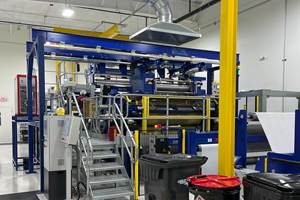Unweighting a crane to increase payload limit
Rethinking a crane stinger with carbon fiber for a more “uplifting experience.”
The payload capacity of a crane depends on the strength and stiffness of the materials used to make the arm. It also depends, ironically, on the arm’s weight. That is, the greater the arm’s weight, the less payload it can bear. Conversely, you can increase the payload capacity of the crane by reducing the mass of its arm. In other words, the crane arm is an ideal application for composites.
The Manitowoc Co., a crane manufacturer located in Shady Grove, PA, US, recognized this advantage and decided to target the stinger or fly jib — the final segment of an articulating crane arm — on one of its truck-mounted cranes, replacing the traditional 24-ft (7.3m) steel structure with one of carbon fiber composite.
Sammy Munuswamy, senior principal engineer, global engineering and innovation at Manitowoc, says the company is “in the business of building lifting experiences for our customers around the world.” And a quality “lifting experience,” in Manitowoc’s view, should be one where the tool (crane) facilitates the jobs to be done at a variety of jobsite environments, including buildings, roadsides, heavy construction sites and more. “Cranes are getting lighter,” Munuswamy says, “and we need materials to meet that expectation. The stinger section was identified as an ideal candidate for conversion into a carbon fiber light-weight structure since the outermost crane arm components generate the highest bending moments on the crane. Therefore, reducing weight in such members brings the most tangible benefits.”
The stinger was developed by Manitowoc in collaboration with Riba Composites Srl (Faenza, Italy), which has extensive experience designing and manufacturing large composite structures. Munuswamy says one of the challenges the company faced was the reality that cranes, as a cost-sensitive, low-volume product, do not allow for expensively engineered structures. In addition, the composite stinger is a drop-in replacement for its predecessor.
Because the carbon fiber stinger works as a component retrofit compatible with existing cranes, Riba's engineers exploited all the available design space, maximizing the moment of inertia and the geometric properties of the stinger. The result is a hybrid structure where steel and composite match to take advantage of the specific properties of each material. The junction between steel and composite relies on bonding and bolts, which allow an effiient solution.
Andrea Bedeschi, general manager at Riba, says the composite stinger is hand-laid, using carbon fiber prepreg and autoclave cure. The carbon fiber, standard-modulus 12K and 24K tow, is supplied by Mitsubishi Chemical Carbon Fiber & Composites Inc.. The resin is a toughened epoxy. Riba performed NDT evaluation of the stinger; physical load, stability and structural performance testing was done by Manitowoc.
The composite stinger is 35% lighter than its steel predecessor and, says Munuswamy, increases payload capacity 12-15% more than the steel version in some specific boom configurations. The composite stinger also is more expensive than its steel predecessor, but Munuswamy says this is more than compensated for by increased jobsite efficiency and transportability.
Will Manitowoc expand carbon fiber use to other crane components? “This [the stinger] is leading us in that direction,” Munuswamy says. “The stinger was the first step.”
Related Content
Scott Bader ATC begins Crestabond MMA structural adhesive production
Scott Bader’s Drummondville, Canada, facility has begun manufacturing and supplying composites-applicable adhesives to its North American customers.
Read MoreEpoxy-based structural film adhesive intended for aerospace, MRO
CAMX 2023: Park Aerospace is presenting its new aerospace-grade film adhesive material Aeroadhere FAE-350-1, in addition to other product offerings intended for aerospace, defense and spacecraft.
Read MoreHenkel releases digital tool for end-to-end product transparency
Quick and comprehensive carbon footprint reporting for about 58,000 of Henkel’s adhesives, sealants and functional coatings has been certified by TÜV Rheinland.
Read MoreXlynX Materials BondLynx and PlastiLynx for low surface energy PP, PE substrates
Award-winning Xlynx materials use breakthrough “diazirine” technology to boost bond strength up to 950% as adhesives, primers and textile strengtheners.
Read MoreRead Next
From the CW Archives: The tale of the thermoplastic cryotank
In 2006, guest columnist Bob Hartunian related the story of his efforts two decades prior, while at McDonnell Douglas, to develop a thermoplastic composite crytank for hydrogen storage. He learned a lot of lessons.
Read MoreCW’s 2024 Top Shops survey offers new approach to benchmarking
Respondents that complete the survey by April 30, 2024, have the chance to be recognized as an honoree.
Read MoreComposites end markets: Energy (2024)
Composites are used widely in oil/gas, wind and other renewable energy applications. Despite market challenges, growth potential and innovation for composites continue.
Read More
















.jpg;maxWidth=300;quality=90)







